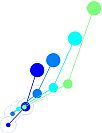Visual virtual reality (VR) systems offer advantages for investigating the neural basis of complex behavior in head-fixed mice by enabling precise control of sensory input. However, the impact of VR environmental richness on learning and behavioral strategy remains unclear. To address this, we trained head-fixed mice on a closed-loop virtual foraging task. Mice ran on a linear treadmill while navigating a corresponding virtual corridor containing two visually distinct foraging sites. Reaching a site triggered a retractable waterspout; licking the spout probabilistically delivered a reward and/or depleted the site. We compared two groups: a control group in a still and featureless virtual corridor and an experimental group navigating a patterned virtual corridor. Both groups learned the task at similar rates, but mice in the enriched VR environment switched between foraging sites more readily, a hallmark of efficient foraging. These mice displayed improved anticipatory behavior, faster reaction times, and higher overall task efficiency, suggesting a more accurate internal representation of the virtual environment and its underlying rules. These findings show that environmental richness in VR significantly impacts both learning and strategic decision-making, highlighting the importance of immersive environments for studying complex behaviors and their neural underpinnings in head-fixed animal models.

 PDF version
PDF version
